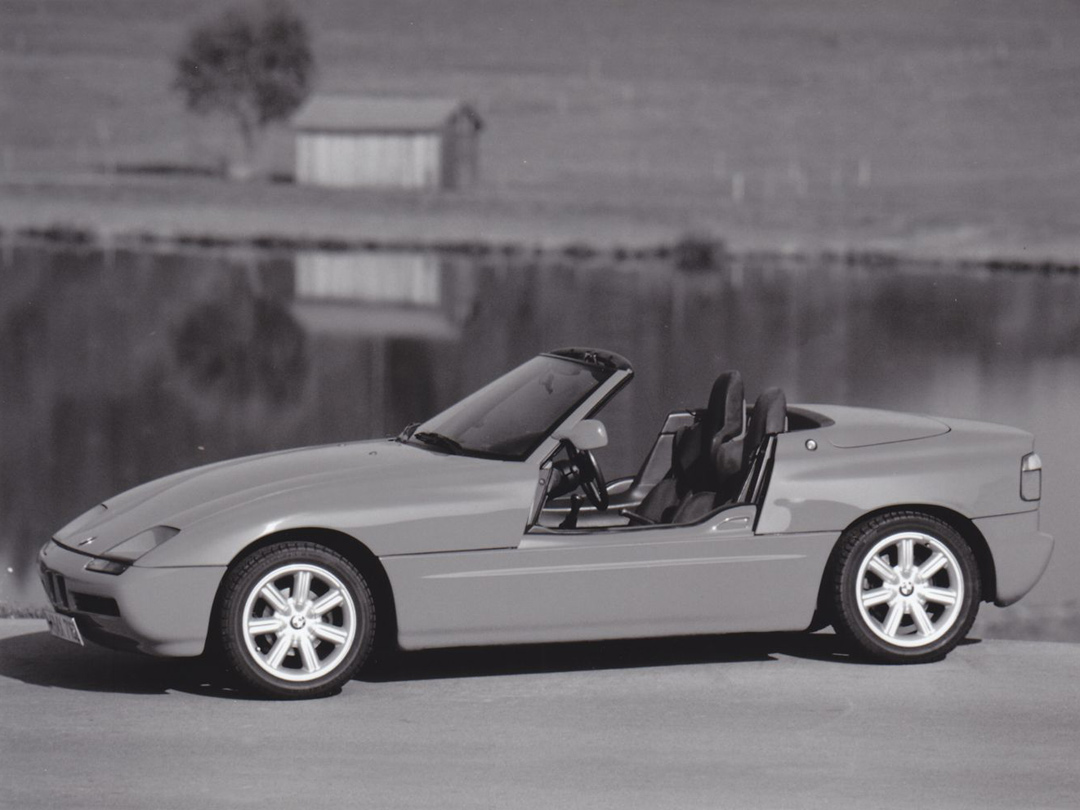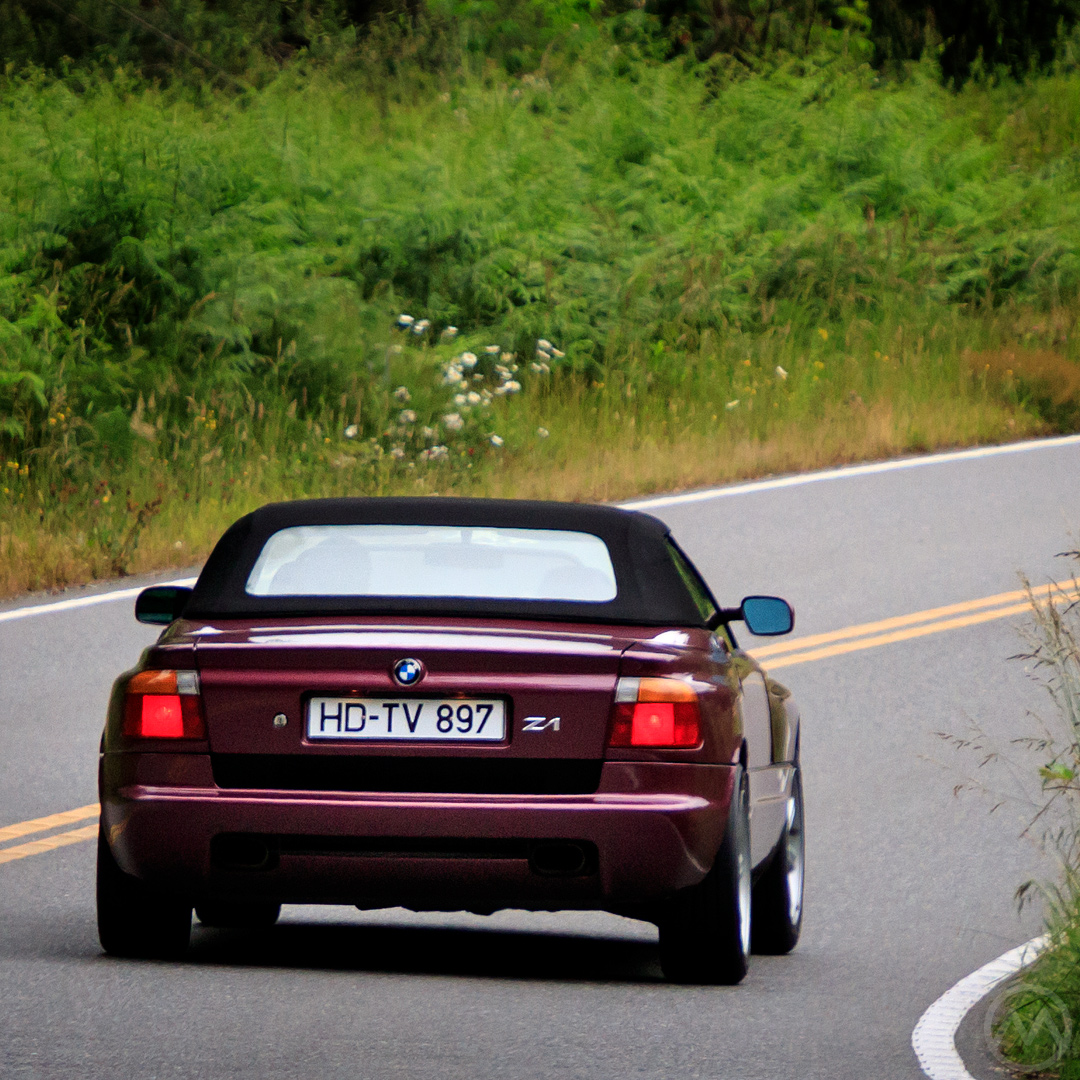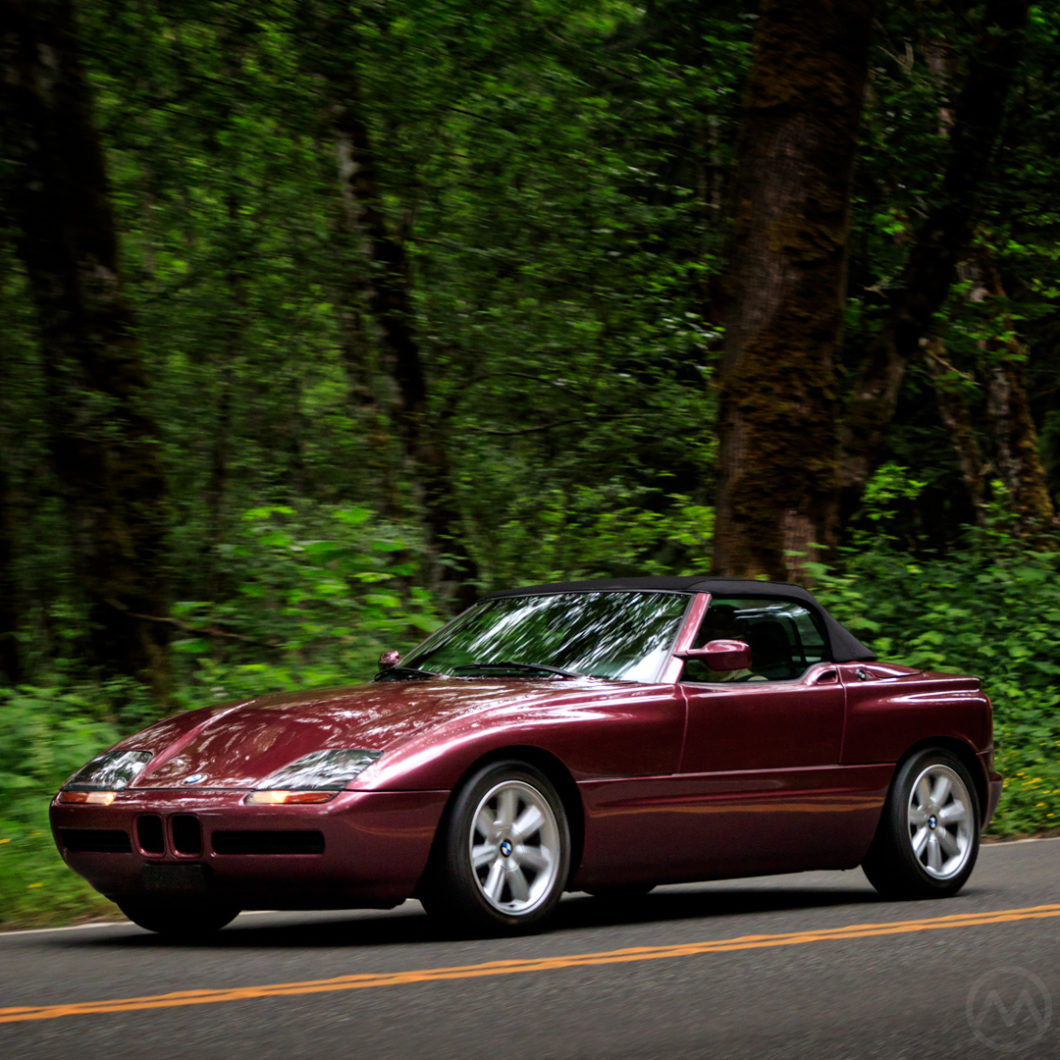The tall sides and wedge shape may say “eighties,” but the BMW Z1 still looks like the future even 30+ years after it broke cover. Z is for zukunft – German for future – and the future arrived in the fall of 1988. That October, actual reviewers hopped into actual production Z1s and set off blasting around the hills around Punta Ala on the Tuscan coast. It had been a whirlwind three year evolution.
The Z1 was the first fruit of a new part of BMW set up in early 1985 – BMW Technik AG. Flying high from the huge growth of the previous decade, BMW board member and R&D director Wolfgang Reitzle helped establish Technik as a stand-alone think tank where Munich’s most talented staff could let their imaginations run wild in an environment separate from the usual development processes.
Technik was run by Ulrich Bez, who later described it as a pure blue-sky research lab set up with a 10M Deutsche Mark budget and 60 or so designers – engineers, designers, researchers. Perhaps with an eye towards circumventing BMW’s traditional orthodoxies, many of Techniks’ employees actually came from outside of BMW. One of them was exterior designer Harm Lagaay, who Bez personally recruited from Ford of Germany.
Both Bez and Lagaay had come from Porsche and would eventually return there – but in the summer of 1985 imaginations at BMW ran wild with a purpose. Technik’s first task was to come up with an exciting concept car that would act as a prototype for new technology while also exciting the public about future BMWs.
By August Reitzle and the board were presented with plans for a radical roadster concept. Technik’s mission was to explore new ideas for things like crash structures, suspensions, and composite panels, all of which were part of the idea, and to come up with striking new designs. Bez and Lagaay were both sports car people, although it’s not clear whether they came up with the roadster on their own or were asked to do a 2-seat sports car from the outset.
The team may have been tasked with coming up with a dream car, but the proposal had some grounding in production realities. You know – just in case.
Technik got almost immediate approval to go ahead and build a prototype, which was revealed to the public a year later. BMW played it coy for a year, but knew a hit when they saw one.
Creating the BMW Z1
Bez had come from Porsche in 1982 and, before BMW Technik, had directed vehicle pre-development. One of the goals of Technik was cutting down the lengthy development time of BMW projects – the E30 had been designed largely in 1977-78 but didn’t reach production until late 1982.
The parts that took the longest to create and fine tune were electronics, structures, body panels, and suspensions, and it was the latter three areas that Technik focused on with the Z1.
Key to making efficient and fast cars is making them light but strong – a difficult task for mainstream cars in the post-OPEC era. The entire design was built around a steel space frame with zinc-welded seams reinforced with fiberglass and epoxy resin.
The floorpan was also made of composite materials for lightness and for corrosion resistance. Technik worked with Messerschmitt Boelkow Blohm (MMB, now part of EADS) to develop the floors – which were another sandwich of fiberglass and polyurethane foam. The lightweight pieces were then bonded to the steel structure.
The body panels were meant to be purely cosmetic – lightweight and not load bearing. They too were made from a new material, GE’s Xenoy plastic. At least one of the designers was already familiar with Xenoy – Harm Lagaay had worked on the Ford Sierra, which employed it in the bumpers.

The Z1 was not the first space-frame car with plastic panels. Pontiac had already built more than 100,000 Fieros before BMW Technik was even formed, and no doubt BMW had seen that development. Xenoy made a big difference in how durable plastic panels might be over time. The Xenoy panels were lighter and more flexible than some of the types of plastic used in the Fiero.
The traditional BMW rear trailing arms were replaced with a multi-link, double-wishbone setup called the Z-axle. Suspension designer Rudolf Müller created the Z-axle specifically to fit in the frame’s tight confines, but it worked very well at providing more neutral handling and ended up being a prototype for future rear suspensions, with the Z-axle becoming a regular feature of production BMWs in the 1990s.
The structure had huge sills to provide torsional rigidity and side impact protection while keeping weight down, and it was this element that led to the trademark sliding doors.
The Style Council
Although the design is usually credited solely to Lagaay, it’s almost never the case that a lead designer does the whole thing. The Technik team was smaller than a normal team, but not that small. A diverse group at Technik worked on creating and refining the Z1’s shape, inside and out.
Born in the Hague, Lagaay started his career with Simca but was hired away by Tony Lapine at Porsche in 1971, where he worked on the 924. He later left Porsche for Ford, eventually heading Ford’s Cologne studio and having direct input into the Mk3 Escort and the Sierra and Scorpio working under Uwe Bahnsen and with Patrick Le Quément. Bez hired him in May of 1985, and he’d sketched out an early idea by August.
It was a radical wedge devoid of any chrome but suffused with subtle muscular bulges. There were minimal overhangs – a proper barchetta.
At first it was a little softer than the production car, and the prototypes went through extensive reworks in sketches (with much input from young designer Patrick Ayoub, freshly recruited from the Art Center college of Design) modeling (by modeler Luc Landuyt and others) and heavy aerodynamics work done by Klaus Faust.
Faust’s efforts in the wind tunnel removed any need for spoilers or wings by creating an integrated diffuser at the rear of the car, which helped keep the rear end stable and planted at high speed. This was another idea that would end up production-bound on other BMWs.
The Z1 did not have a particularly low drag coefficient, but the aerodynamics work meant no ornamentation by aero aids, which gave it a particularly clean look. Up front, the glassed-in headlights used early projector beams and the trademark BMW grill was subtly integrated into the front bumper.
One element that wouldn’t be included on other cars were the sliding doors. Necessitated by the huge sills, the car’s novel doors slid down into channels at the touch of a button, though they could be operated without power if the need arose. There was no other vehicle like this apart from perhaps the Kaiser-Darrin of the 1950s, whose doors slid forward, rather than down. The car could be driven safely with the doors down for an experience not unlike a Triumph TR-3.

Early on, despite the emphasis on “new” technology, the engineering and styling teams agreed that the car should be front-engined. It would make it possible to borrow components wholesale from the E30 – as the brief did not really involve designing new engines, creating a new drivetrain layout would just make the timeline longer. The Z1, even in prototype form, borrowed the E30’s M20 six and front suspension.
The interior was in part the work of Sabine Zemelka, hired away from Audi after 11 years with Ingolstadt. The interior was purposeful, functional, modern, and wide – the Z1 may not have been very big but it felt wide, and it’s a testament to how forward thinking it was that the later Z4 models still had some of the spirit of the original’s setup.
The prototype car was ready to roll in late July of 1986, with a second prototype nearly completed. To gauge reaction, BMW decided to leak the car to Auto Motor und Sport, and then to Autocar in the U.K. that August – just one year after greenlighting the prototype.
Building the BMW Z1
Journalist Jürgen Lewandowski was the first person outside of BMW to drive the prototype, and although BMW would not allow him to see anything under the skin, he liked it right away. In fact, everyone who saw it liked it, though none had driven it. BMW put out a press release detailing how the car was a concept built to “satisfy the desire for ‘freedom on four wheels.’”
Although BMW would not confirm or deny that it planned to build the car for another year, work almost immediately began on ways to productionize it. Despite borrowing liberally from the E30 parts bin, it was still a highly specialized idea car and could not be easily integrated into BMW’s existing production facilities. Its components would be labor intensive to put together even in a best case scenario.
Still, work continued on ways to make the car acceptable to regular buyers and easy to produce, including developing a paint process with AKZO called “flexible lacquer” and sourcing fiberglass pieces for some of the body (hood, doors, trunk lid) from contractor Seger & Hoffman.
The public, meanwhile, wanted the car. They didn’t know how much they’d be willing to pay for it, but Munich kept getting inquiries about it. Finally – a year after the press teasing – on August 10, 1987, they made it official that they would, in fact, be building it. By hand.
The mechanical spec was not going to change – the E30 front suspension, the 168-hp, 2.5 liter M20 six, and the Getrag 5-speeder were carried over directly, though the engine was tilted 20 degrees due to the low lines of the car. Much of the electronics were E30 as well.
A month later, it made its public debut at the Frankfurt show, where crowds mobbed the stand for virtually the whole show. By this point, ten prototypes had been built, and the first one had cost 2,000,000DM.
It took a year to get the car homologated for sale in Europe – no attempt was made at certification for North America since the doors would have made it almost impossible and no right-hand-drive version was planned.
While German authorities were testing the car, the production line was set up in a corner of BMW’s Munich plant. At first the company projected it could build six a day, then twelve. In reality, they were able to build 16 cars a day once production ramped up in 1989.
Punta Ala
Once real production was underway, BMW scheduled a press launch even though it had thousands of pre-orders (up to 35,000 were later claimed, but the real figure was probably 4,000). The Z1 turned out to be just as good to drive as it looked – not overly fast given that it had to make due with the regular 325i engine, but well balanced and (for the time) bank vault solid.
The test drives on the Tuscan coast were in October, and BMW Z1 deliveries began shortly thereafter.
Early Z1s could be had with an extra set of body panels in a different color. Like the Fiero, all of the panels were removable, and BMW claimed they could be changed in an hour – although it might require an F1 pit crew to actually do it in that time frame. A hardtop was also available from Weismann, though it was not an official factory item.
Hand built or no, the car was good to drive and unmistakably cool. BMW was certain that it would be a good seller even if production was slow. It cost 83,000DM, expensive, but not so much for a hand-built semi-exotic.
At the time, the classic car market was white hot with newly-appreciated investment cars, particularly Ferraris but also other classic vehicles from the 1930s to the 1950s. One of those cars was the BMW 507, Munich’s last great roadster and a vehicle which put in a cameo at Punta Ala for the press debut of the Z1.

The speculative boom of the era, fueled in part by buyers from Japan, eventually crossed over into new cars – slightly used Ferraris in 1989 were selling for more than the factory prices of new cars. That sparked a trend towards speculation of all sorts on many sports cars – and some of the pre-orders for the Z1 may have been part of this phenomenon.
Most of the Z1 orders came from Germany and Italy, which fairly well insulated the car from Japan’s bust a year later, but even by the time of the Punta Ala launch economic headwinds were buffeting Europe following the Black Monday crash in 1987.
Orders seemed to dry up after the end of 1989 and BMW kept building it at a reduced pace into 1991. Ultimately, 8,000 BMW Z1 roadsters were made.
Epilogue
By the time the car was launched Ulrich Bez had returned to Porsche, where he soon began working on the 993 911. Lagaay followed him a year later, becoming the new Chief Design Officer at Porsche – an offer nobody could have refused.
BMW Technik, meanwhile, kept working on advanced designs outside of the scope of regular BMW development. There was soon a proposal for a shooting-brake like Z2 coupe based on the Z1 – though it didn’t go anywhere, it may have informed the later Z3 coupe. That was the first of many Z cars created by the think tank – many of them sports cars or EVs, well into the early 2000s. In 2003, BMW’s management had the group turn more towards vehicle systems.
The Z1, meanwhile, quickly became a collectors’ item thanks to its low production numbers. It was one of the few younger vehicles to be eligible for importation to the USA under the “show or display” law enacted in 1999 at the best of some very wealthy enthusiasts who could see no reasonable way to make their vehicles compliant with US DOT and NHTSA regulations.
In 2014, when it turned 25, it became much easier to import to the USA, and more than a few have trickled in since.
In the early 1990s BMW tried again and developed the Z3, a much more conventional vehicle in every respect but one aimed at mass production from the start. The Z1 and the success of the Mazda MX-5 had validated the idea, it just needed to be something that could be churned out in a more economical way. That, however, is a story for another day.

